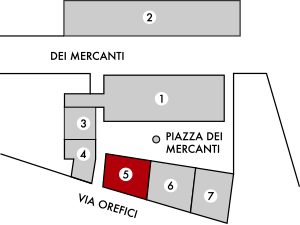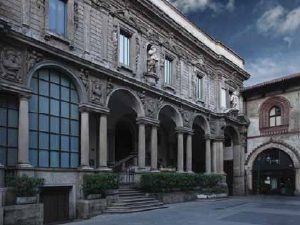All’inizio del ‘600 Ericio Puteano, giovane fiammingo,
amico del cardinale Federico Borromeo, fu incaricato di riformare le Scuole del Broletto. La piazza era da secoli il luogo che ospitava scuole che vantavano filologi e giuristi come insegnanti di spicco. Per tutto il Medioevo mancò un organico ordinamento legislativo relativamente all’istruzione, che era privata, tutt’al più sovvenzionata da elargizioni di signori o gruppi professionali. In piazza Mercanti però, essendovi il Collegio dei Giureconsulti da cui arrivavano gli insegnanti di diritto, fin dalla seconda metà del ‘400 si andò definendo una formazione legata a tale presenza: le Scuole del Broletto. Ericio Puteano, che ai primi del ‘600 vi insegnava latino, diede enfasi alle scuole chiamandole Palatine, a ricordo dei fasti della più nota Accademia  palatina di Carlo Magno. Al di là del nome altisonante, erano effettivamente scuole di specializzazione superiore in eloquenza latina, lingua greca e diritto. Un anno alle Palatine valeva come un anno del corso di laurea in legge a Pavia. Ancora nel ‘700 le Scuole rappresentarono un luogo di formazione in materie giuridiche ed economiche. In verità le lezioni non sempre si tenevano in questo luogo, insufficiente alla richiesta, che però istituzionalmente ne manteneva il ruolo per le cerimonie ufficiali e le lezioni inaugurali. Nel 1773 le Scuole furono infatti trasferite nella sede più adatta del Palazzo di Brera. L’edificio delle ex Scuole Palatine fu sede nell’800 della Camera dei Notai, poi luogo di una bottega e ancora nel 1896 adibito a uffici della Camera di Commercio. Successivamente il Palazzo passò all’Unione italiana cereali e infine a un privato.
palatina di Carlo Magno. Al di là del nome altisonante, erano effettivamente scuole di specializzazione superiore in eloquenza latina, lingua greca e diritto. Un anno alle Palatine valeva come un anno del corso di laurea in legge a Pavia. Ancora nel ‘700 le Scuole rappresentarono un luogo di formazione in materie giuridiche ed economiche. In verità le lezioni non sempre si tenevano in questo luogo, insufficiente alla richiesta, che però istituzionalmente ne manteneva il ruolo per le cerimonie ufficiali e le lezioni inaugurali. Nel 1773 le Scuole furono infatti trasferite nella sede più adatta del Palazzo di Brera. L’edificio delle ex Scuole Palatine fu sede nell’800 della Camera dei Notai, poi luogo di una bottega e ancora nel 1896 adibito a uffici della Camera di Commercio. Successivamente il Palazzo passò all’Unione italiana cereali e infine a un privato.
At the beginning of the seventeenth century Erycius Puteanus, a young Flemish scholar who was a friend of Cardinal Federico Borromeo, was given the task of reforming the Scuole del Broletto. For centuries, schools boasting philologists and jurists as their leading teachers had been located in the piazza. Throughout the Middle Ages there had been a lack of an organic body of rules relating to the teaching, which was private and at the most financed by donations from individuals or professional groups. In Piazza Mercanti, however — since the Collegio dei Giureconsulti, where the law teachers came from, was located there — from the second half of the fifteenth century onwards a school system linked to this was developed: the Scuole del Broletto. Erycius Puteanus, who taught Latin there in the early seventeenth century, called the schools ‘Palatine’, harking back to the glories of Charlemagne’s more celebrated Palatine Academy. Despite their high-sounding name, they were effectively schools offering advanced courses in Latin oratory, Greek and law. A year at the Scuole Palatine was the equivalent to a year of the degree course in law at the University of Pavia. In the eighteenth century the schools were still important for the teaching of law and economics. Although, because of its limited size, not all the lessons were held in this building, it continued to house official ceremonies and inaugural lessons. However, in 1773 the schools were moved to more suitable premises in the Palazzo di Brera. In the nineteenth century the former Scuole Palatine building was the headquarters Chamber of Notaries, then it became a shop and, in 1896, it was used for the offices of the Chamber of Commerce. Subsequently the palace was taken over by the Unione italiana cereali (Italian Grain Producers’Association) and, finally, by a private individual.
Flemish scholar who was a friend of Cardinal Federico Borromeo, was given the task of reforming the Scuole del Broletto. For centuries, schools boasting philologists and jurists as their leading teachers had been located in the piazza. Throughout the Middle Ages there had been a lack of an organic body of rules relating to the teaching, which was private and at the most financed by donations from individuals or professional groups. In Piazza Mercanti, however — since the Collegio dei Giureconsulti, where the law teachers came from, was located there — from the second half of the fifteenth century onwards a school system linked to this was developed: the Scuole del Broletto. Erycius Puteanus, who taught Latin there in the early seventeenth century, called the schools ‘Palatine’, harking back to the glories of Charlemagne’s more celebrated Palatine Academy. Despite their high-sounding name, they were effectively schools offering advanced courses in Latin oratory, Greek and law. A year at the Scuole Palatine was the equivalent to a year of the degree course in law at the University of Pavia. In the eighteenth century the schools were still important for the teaching of law and economics. Although, because of its limited size, not all the lessons were held in this building, it continued to house official ceremonies and inaugural lessons. However, in 1773 the schools were moved to more suitable premises in the Palazzo di Brera. In the nineteenth century the former Scuole Palatine building was the headquarters Chamber of Notaries, then it became a shop and, in 1896, it was used for the offices of the Chamber of Commerce. Subsequently the palace was taken over by the Unione italiana cereali (Italian Grain Producers’Association) and, finally, by a private individual.